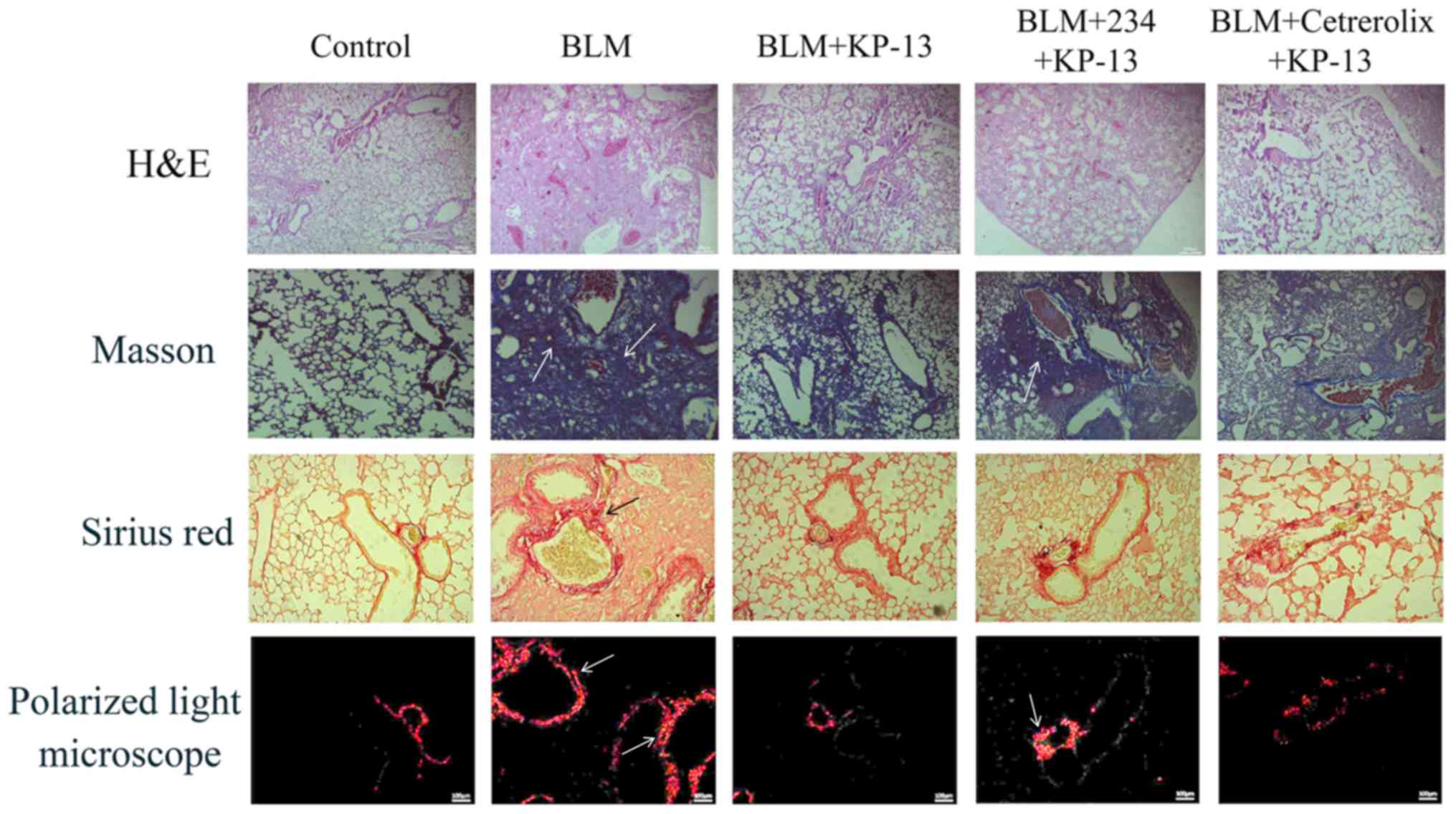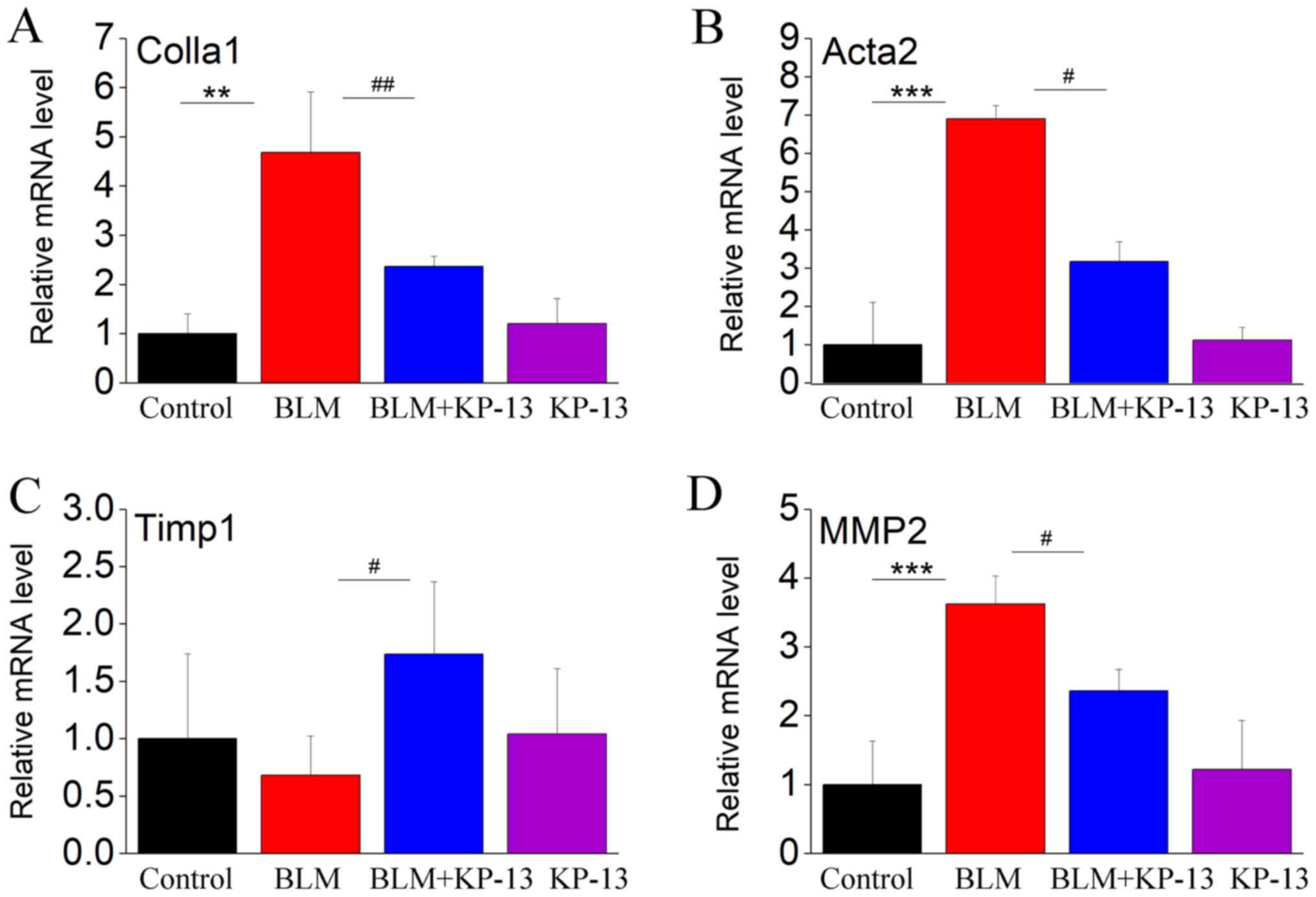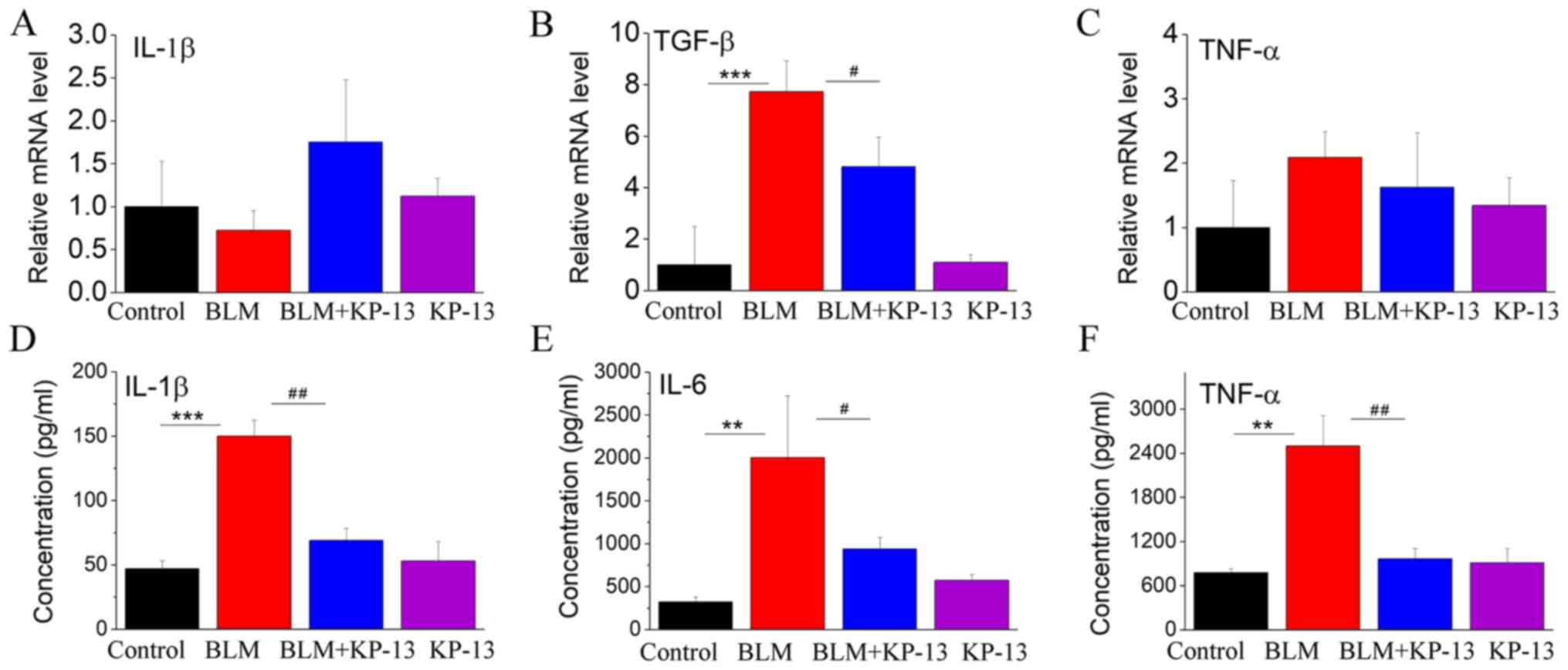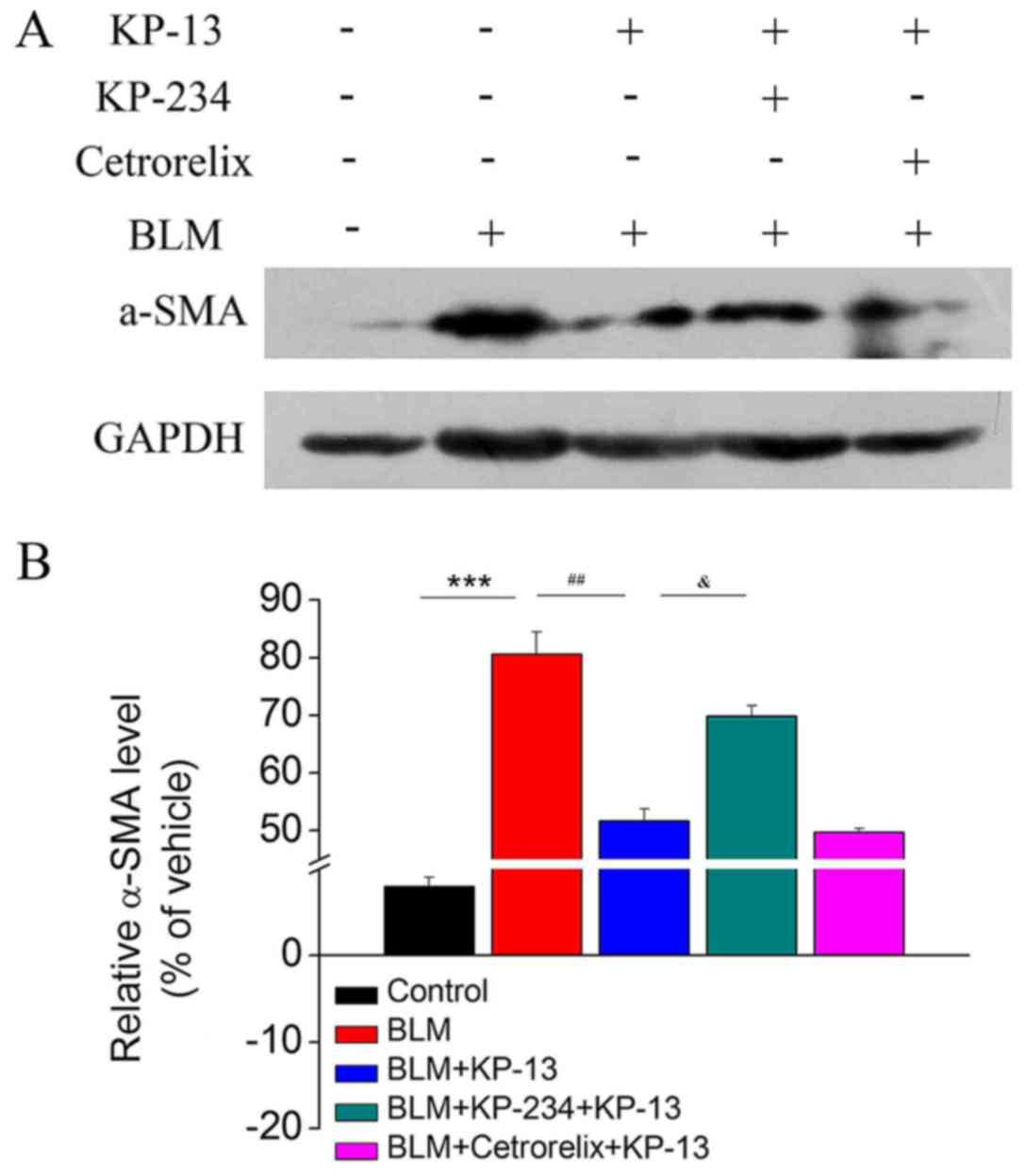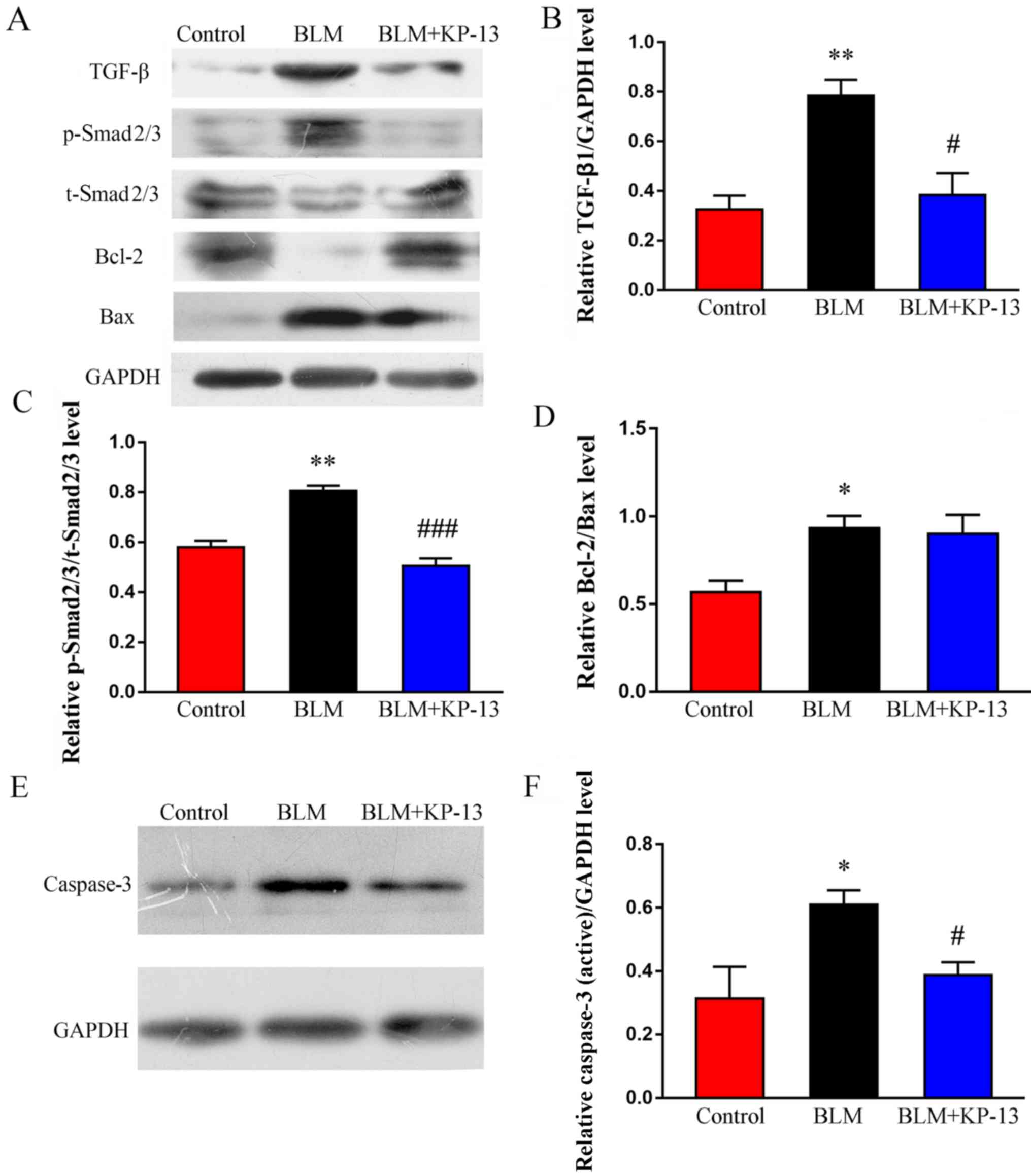Kisspeptin‑13 inhibits bleomycin‑induced pulmonary fibrosis through GPR54 in mice
- Authors:
- Published online on: June 5, 2019 https://doi.org/10.3892/mmr.2019.10341
- Pages: 1049-1056
-
Copyright: © Lei et al. This is an open access article distributed under the terms of Creative Commons Attribution License.
Abstract
Introduction
Idiopathic pulmonary fibrosis (IPF) is an invariably fatal disease characterized by the accumulation of excess extracellular matrix components, and it can severely compromise lung function, which is characterized by progressive dyspnea and coughing (1,2). Despite the progress reported by clinical trials on IPF over the last decade, the pathogenesis and progression of IPF have not yet been fully elucidated. Although immunosuppressive therapy has been effective in slowing down the progression of IPF, its deleterious side effects have led to the reconsideration of its use in IPF (3,4). Thus far, the currently used agents, such as immunosuppressants and steroids, have not been found to improve the prognosis. There is an urgent need for effective therapeutic agents for IPF.
Kisspeptin (KP), also referred to as metastin, is encoded by the KiSS-1 metastasis suppressor (KISS-1) gene and serves as the ligand for G protein-coupled receptor 54 (GPR54), a Gq/11-coupled receptor also referred to as AXOR12 or hOT7T175. KP is proteolytically cleaved into several active polypeptides, including KP-54, KP-13 and KP-10. Tian et al (5) reported that the KISS1 gene is a downstream target of the classic transforming growth factor-β (TGF-β)/Smad2 signaling pathway. The KP/GPR54 signaling pathway plays an important role in initiating the secretion of gonadotropin-releasing hormone (GnRH) at puberty, and is involved in the regulation of the GnRH/GnRH receptor (GnRHR) signaling pathway (6). Previous research has provided substantial evidence supporting the role of the KISS-1/GPR54 signaling pathway in the regulation of the reproductive axis, including the timing of puberty, the sexual differentiation of the brain, the regulation of GnRH at puberty, as well as in diabetes, adiposity, atherogenesis (7), gastrointestinal motility (8), learning and memory (9), and suppression of metastasis across a range of cancer types (10,11).
A number of neuroendocrine factors, including hypothalamic-pituitary-adrenal/hypothalamic-pituitary-gonadal (HPA/HPG) axis-related hormones and GnRH, regulate the homeostasis between cell proliferation and apoptosis (12,13). Disruption of this homeostasis leads to inflammatory changes or fibrosis. For example, Kyritsi et al (14) reported that inhibition of the hepatic expression of the GnRH/GnRHR1 axis by Cetrorelix reduced biliary duct proliferation and liver fibrosis. McMillin et al (15) reported that infusion of melatonin reduced cholangiocyte proliferation, hepatic injury and fibrosis during bile duct ligation-induced liver injury. These previous studies provided novel insight into the use of the KISS1/GPR54/GnRH axis as a potential target for the treatment of fibrosis or inflammation.
To the best of our knowledge, at present, no data have been published regarding the role of KP-13 in pulmonary fibrosis. The aim of the present study was to determine whether KP-13 is able to attenuate bleomycin (BLM)-induced pulmonary fibrosis in mice, and investigate the underlying mechanisms.
Materials and methods
Animals
Male C57BL/6 mice (weighing 20–22 g, 8–10 weeks-old) were purchased from the Experimental Animal Center of Lanzhou University. All mice were housed in cages (humidity 45–50%, sizes 20×30 cm2, bedding-wood shavings, 6 animals/cage) with free access to tap water and food in a room, which was maintained at 22±2°C in a 12-h light (8:00 a.m.)/dark (8:00 p.m.) cycle. All animal protocols in the present study were approved by the Ethics Committee of Lanzhou University (approval no. SYXK Gan 2009-0005).
Establishment of the pulmonary fibrosis model
The animal model of pulmonary fibrosis in the present study was established according to the protocols previously described by Tian et al (16), Luque et al (17) and Wei et al (18). Briefly, mice were anesthetized by an intraperitoneal (i.p.) injection of 70 mg/kg pentobarbital sodium (Sigma-Aldrich; Merck KGaA), and were intratracheally administered 4 mg/kg BLM (Sigma-Aldrich; Merck KGaA) to induce fibrosis. A total of 54 mice were randomly assigned to six groups of 9 mice each as follows: i) Control group, instilled with saline alone; ii) BLM group, instilled with BLM alone; iii) BLM+KP-13 group, instilled with BLM and treated with KP-13 [1 mg/kg, i.p.]; iv) BLM+KP-234+KP-13 group, instilled with BLM and treated with KP-234 (1 mg/kg, i.p.) and KP-13 (i.p.); and v) BLM+Cetrorelix+KP-13group, instilled with BLM and treated with Cetrorelix and KP-13 (i.p.). vi) KP-13 group were only treated with KP-13 (i.p.). After intratracheal instillation of BLM, the mice received all the injections daily from the third day up to 28 days. KP-13 and KP-234 were provided by Dr Min Chang (Lanzhou University). KP-13 and KP-234 were first dissolved in 2% DMSO and diluted in saline immediately prior to injection, as previously described (9). Cetrorelix (Sigma-Aldrich; Merck KGaA) was dissolved in saline and injected i.p. (1 mg/kg/10 ml) 30 min prior to KP-13 injection. The mice were sacrificed on day 28 after injection of BLM. All experiments were performed between 9:00 a.m. and 6:00 p.m. In addition, the dose selection was based on previous studies by Jiang et al (8,9).
Histological analysis
The histopathological assay was performed, according to previous studies. Briefly, whole left lungs were fixed in 4% paraformaldehyde at 4°C overnight and embedded in paraffin. The 8-µm sections were stained with hematoxylin and eosin (H&E), Masson's trichrome stain and Picro-Sirius Red (PSR), using standard methods. The images were performed by an ordinary optical microscope (H&E and Masson) and polarized light microscope (PSR; Zeiss AG).
Reverse transcription-quantitative PCR (RT-qPCR)
RT-qPCR was conducted according to the manufacturer's protocol (Takara Bio, Inc.). Total RNA was extracted using TRIzol® reagent (Thermo Fisher Scientific, Inc.) following the manufacturer's protocol and 1 µg RNA sample was reverse transcribed into cDNA with the 5X PrimeScript RT Master Mix (Takara Bio, Inc.), the following conditions: 37°C for 15 min, 85°C for 5 sec, 4°C for 3 min. Amplification was conducted in a 25 µl reaction compound composed of 12.5 µl 2X SYBR Premis Ex TaqII (Takara Bio, Inc.), 8.5 µl ddH2O, 2 µl cDNA, 1 µl forward primer and 1 µl reverse primer, and was carried out under the following conditions: 95°C for 30 sec, followed by 40 cycles at 95°C for 5 sec, 60°C for 30 sec and 72°C for 30 sec. Gene expression was evaluated using the 2−∆∆Cq method (19) where ∆Cq=Cqtarget gene-CqGAPDH and ∆∆Cq=CqDrug-CqControl. The primers are presented in Table I and GAPDH was used as the reference gene.
Western blotting
Western blotting was performed following the manufacturer's protocol (Bio-Rad Laboratories, Inc). Protein was extracted with RIPA buffer containing protease inhibitor (Gibco; Thermo Fisher Scientific, Inc.). The protein concentration was determined using a BCA protein assay kit (Pierce; Thermo Fisher Scientific, Inc.). The protein samples (40 µg per lane) were separated by SDS-PAGE on 10% gels and then transferred onto PVDF membranes. The membranes were blocked in 5% fat-free milk in TBST (0.1% Tween-20) at room temperature for 2 h, and incubated with specific antibodies overnight at 4°C as follows: Anti-α-smooth muscle actin (α-SMA; cat. no. 19245; 1:1,000; Cell Signaling Technology, Inc.), anti-TGF-β (cat. no. 3711; 1:1,000; Cell Signaling Technology, Inc.), anti-phosphorylated (p)-Smad2/3 (cat. no. 8828; 1:1,000; Cell Signaling Technology, Inc.) or anti-total (t)-Smad2/3 (cat. no. 3102; 1:1,000; Cell Signaling Technology, Inc.), anti-Bcl-2 (cat. no. D198628-0100; 1:500; BBI Life Sciences), anti-Bax (cat. no. D190756-0100; 1:500; BBI Life Sciences), anti-active caspase-3 (cat. no. D195315-0100; 1:500; BBI Life Sciences) and anti-GAPDH (cat. no. 5174; 1:2,000; Cell Signaling Technology, Inc.). After washing three times with PBS, the membranes were incubated with horseradish peroxidase-conjugated secondary antibodies (cat. no. A0208, 1:5,000; Beyotime Institute of Biotechnology) at room temperature for 1 h. The result was visualized with chemiluminescence reagents using an ECL kit (Thermo Fisher Scientific, Inc.) and exposed to a film. The intensity of the blots was quantified with densitometry (Image J 1.49v; National Institutes of Health).
ELISA
Total protein from the lungs of mice in each group were extracted with RIPA lysis buffer containing protease inhibitor (Gibco; Thermo Fisher Scientific, Inc.). Total proteins were determined using a bicinchoninic acid protein assay kit (Sangon Biotech Co., Ltd.). Interleukin (IL)-1β, IL-6 and tumor necrosis factor-α (TNF-α) in the lung tissue were measured using ELISA kits (cat. no. E-EL-M0049 for TNF-α, cat.no. E-EL-M0044 for IL-6, cat. no. E-EL-M0037 for IL-1β, Elabscience), according to the manufacturer's protocol.
Statistical analysis
All data are presented as the mean ± SEM for two repeats twice of each experiment. Overall survival was defined as the time period from the first day of BLM-induced pulmonary fibrosis to the date of succumbing, or until the 28th day of BLM-induced pulmonary fibrosis. Comparisons of mortality were made by analyzing Kaplan-Meier survival curves, and then log-rank tests to assess for differences in survival. The statistical analysis was conducted by two-way ANOVA followed by Dunnett's post-hoc test using SPSS 19.0 (IBM Corp.). P<0.05 was considered to indicate a statistically significant difference.
Results
KP-13 attenuates the pulmonary damage and fibrosis induced by BLM in mice
A comparison of 28-day survival curves among the four groups of mice with pulmonary fibrosis revealed that KP-13 improved the survival of mice with BLM-induced (4 mg/kg) pulmonary fibrosis (Fig. 1A). Additionally, mice in the BLM group had lost an amount of body weight between days 2 and 28 compared with the control mice, and it reached a significant difference at 28 days (P<0.001; Fig. 1B). Treatment with KP-13markedly inhibited these changes compared with the BLM group. The increased spleen/body weight ratio reflected the progression of inflammation. As shown in Fig. 1C, BLM treatment increased this ratio, while KP-13 treatment inhibited the increase in the ratio (P<0.05; BLM group compared with BLM+KP-13 group), suggesting that KP-13 suppresses inflammation.
Pulmonary injury and fibrosis induced by BLM in mice were evaluated by histopathological examination. The findings included severe edema, alveolar collapse, alveolar membrane thickening and inflammatory cell infiltration (Fig. 2). H&E, Masson's trichrome and PSR staining revealed severe collagen deposition induced by BLM in the lungs of the mice. However, treatment with KP-13 markedly reversed these changes and alleviated collagen deposition.
KP-13 ameliorates BLM-induced inflammatory injury in the lungs of mice
It was recently demonstrated that BLM-induced pulmonary fibrosis is correlated with alterations in inflammatory cytokines (TNF-α, IL-1β and TGF-β) and fibrosis-related factors [collagen type I α 1 (Colla1), actin α 2 (Acta2), tissue inhibitor of metalloproteinase 1 (Timp1) and matrix metalloproteinase 2 (MMP2)] (16). In the present study, the levels of these factors were increased in response to intratracheal BLM instillation compared with control mice. However, these increases were markedly inhibited by KP-13 application.
As shown in Fig. 3, the mRNA levels of Colla1, Acta2 and MMP2 were significantly increased following intratracheal BLM treatment (P<0.01 for Colla1; P<0.001 for MMP2 and Acta2; Fig. 3). Administration of KP-13 to the mice inhibited the expression of these genes induced by BLM administration (P<0.01 for Colla1; P<0.05 for MMP2 and Acta2; Fig. 3). TIMP1 is a collagenase inhibitory protein in pulmonary fibrosis. Thus, its expression level is inversely related to the level of fibrosis (20). Fig. 3C showed that BLM treated decreased the expression of TIMP1, whereas the decrease was markedly changed by KP-13 application (P<0.05, Fig. 3C). These results reflect the induction of fibrosis by BLM and the beneficial effect of KP-13 on IPF. As IPF is associated with inflammation, the expression levels of related inflammatory cytokines were also evaluated. The protein levels of IL-1β, TNF-α and IL-6, and the mRNA level of TGF-β were statistically significantly increased in the lung following intratracheal BLM treatment (P<0.001 for IL-1β and TGF-β; P<0.01 for TNF-α and IL-6; Fig. 4), while KP-13 injection significantly decreased the expression of those factors (P<0.05).
KP-13 reduces the protein expression of α-SMA in lung tissues
A main characteristic of pulmonary fibrosis is the over-proliferation of α-SMA-positive fibroblasts in the whole lung (21,22). Therefore, the ability of KP-13 to modulate the expression of α-SMA, which is a key marker of myofibroblasts, was further evaluated. The western blotting results demonstrated that BLM treatment upregulated the expression of α-SMA in lung tissues compared with the control group (P<0.001; Fig. 5), whereas the levels of α-SMA were reduced following KP-13 treatment compared with the BLM group (P<0.01; Fig. 5).
Mechanism underlying the inhibitory effect of KP-13 on BLM-induced pulmonary fibrosis
A number of previous studies have demonstrated the physiological and pathological roles of the KP/GPR54 signaling pathway in the regulation of the reproductive system, diabetes, adiposity, inhibition of cancer metastasis, and atherosclerotic plaque progression and instability (11,23–25). Recent studies have also reported that KP is a potent stimulator of GnRH secretion, and GnRH was reported to be associated with inflammation and fibrosis (14,15).
Therefore, KP-234, an antagonist of GPR54, and Cetrorelix, an antagonist of GnRHR, were used to determine whether they could block the anti-fibrotic effects of KP-13. The results revealed that KP-234, but not Cetrorelix, significantly attenuated the effects of KP-13 on BLM-induced pulmonary injury and fibrosis (P<0.05 for BLM+KP-13 group and BLM+KP-234+KP-13 group; Figs. 1, 2 and 5).
KP-13 inhibits the expression of TGF-β and phosphorylation of Smad2/3 in BLM-induced pulmonary fibrosis
TGF-β is a key mediator of pulmonary fibrosis, as it regulates the synthesis of extracellular matrix proteins via the TGF-β/Smad2/3 signaling pathway (26). To elucidate the possible mechanisms through which KP-13 ameliorates BLM-induced pulmonary injury and fibrosis, the effects of KP-13 on the TGF-β/Smad2/3 signaling pathway were examined. As demonstrated by the western blot analysis results (Fig. 6A-C), the expression of TGF-β1, as well as the phosphorylation of Smad2/3, were significantly increased after treatment with BLM (P<0.01 for TGF-β1 and Smad2/3), which was downregulated following KP-13 application (P<0.05 for TGF-β1; P<0.001 for Smad2/3). Furthermore, the levels of pro-apoptosis related proteins, such as Bax and caspase-3 (P<0.05 for between Bax and caspase-3, Fig. 6A, D-F), were increased in the BLM group compared with the control. However, these pro-apoptosis proteins were significantly downregulated after KP-13 application (P<0.05, Fig. 6A, E and F). Meanwhile, anti-apoptosis related protein (Bcl-2) was markedly decreased by BLM, whereas KP-13 upregulated its expression level (Fig. 6A).
Discussion
To the best of our knowledge, the present study is the first to provide evidence demonstrating that KP-13 reduces pulmonary injury and fibrosis induced by BLM, particularly the inflammatory response and massive infiltration of inflammatory cells, and the increased collagen/α-SMA deposition in the lung. In addition, it was demonstrated that a GPR54 antagonist, but not a GnRHR antagonist, was able to block the effects of KP-13 in an animal model of pulmonary fibrosis.
In the present study, severe pulmonary fibrosis was induced in mice 28 days after intratracheal instillation of BLM, which was indicated by body weight loss, increased lung coefficient (data not shown), decreased survival rate and exacerbated histopathological abnormalities, with extensive collagen deposition. By comparing the BLM-induced pulmonary fibrosis between mice with and without KP-13 treatment, it was demonstrated that BLM-induced pulmonary fibrosis was markedly attenuated by KP-13.
The main characteristics of pulmonary fibrosis are over-proliferation of α-SMA-positive fibroblasts and collagen deposition in the whole lung; therefore, targeted inhibition of α-SMA expression in the lung has been found to be an effective therapeutic strategy for pulmonary fibrosis (27). Notably, KP-13 significantly ameliorated pulmonary fibrosis by exerting an inhibitory regulatory effect on the expression of Colla1, Acta2 and MMP2. Furthermore, the expression levels of TNF-α and TGF-β were also markedly decreased in the lung in response to BLM+KP-13 treatment compared with the BLM alone-treated mice. Finally, the western blotting results further illustrated that KP-13 downregulated the expression of α-SMA at the protein level in lung tissues. To summarize, these results demonstrated that KP-13 mitigated BLM-induced pulmonary fibrosis.
A previous study reported that the KP/GPR54 signaling pathway is extensively involved in the regulation of endothelial cells, macrophages, monocytes, cardiomyocytes, and cells of the hypothalamus and extravillous trophoblast (17). Sato et al (28) demonstrated that the KP/GPR54 signaling cascade may serve as a potential therapeutic target for atherosclerotic diseases. Additionally, previous experimental and clinical studies have demonstrated the ability of GnRH agonists to prevent postoperative adhesions, inflammation and fibrosis. McMillin et al (15) reported that GnRH played a key role in activated hepatic stellate cells during cholestatic liver disease. Kyritsi et al (14) demonstrated that targeting the GnRH/GnRHR1 signaling pathway may be a key to the management of hepatic fibrosis during the progression of primary sclerosing cholangitis. Therefore, the present study investigated whether the KP/GRP54 and GnRH/GnRHR signaling pathways were involved in the regulation of IPF progression by KP-13 by using KP-234 and Cetrorelix, the respective antagonists of the mentioned signaling pathways. The findings demonstrated that KP-234, but not Cetrorelix, was able to inhibit the anti-fibrotic effects of KP-13, specifically in terms of body weight loss, decreased survival rate, increased lung coefficient (data not shown), massive infiltration by inflammatory cells and increased collagen/α-SMA deposition in the lungs. Therefore, it was identified that the GPR54 axis, but not the GnRH axis, was involved in the regulation of BLM-induced IPF in mice by KP-13.
Suppression of TGF-β/Smad signaling has been demonstrated to ameliorate experimentally induced fibrosis (29). Previous studies have reported that BLM-induced pulmonary fibrosis may be associated with TGF-β/Smad2/3 signaling (26,30). In the present study, it was observed that the expression of TGF-β and the phosphorylation of Smad2/3 in the lung were markedly upregulated in mice treated with BLM alone, whereas administration of KP-13 significantly inhibited the expression of TGF-β and the phosphorylation of Smad2/3. In addition, treatment with KP-13 markedly upregulated the expression of the anti-apoptotic factor Bcl-2, and downregulated the expression of the pro-apoptotic factor Bax, compared with the BLM group. These data indicated that KP-13 inhibited the enhanced TGF-β signaling in BLM-induced pulmonary fibrosis.
To summarize, the results of the present study indicated that KP-13 exerted antifibrotic effects via inhibition of the inflammatory response and collagen/α-SMA deposition in the lung. Therefore, the KP-13/GPR54 axis may represent a promising therapeutic target for preventing the progression of pulmonary fibrosis. However, whether the GPR54/KP systems can be used as targets for pulmonary fibrosis in the clinic remains to be further studied.
Acknowledgements
Not applicable.
Funding
The present study was funded by the grants from Gansu province Natural Science Foundation of China (grant no. 1506RJZA278) and Gansu Provincial Key Laboratory Open Foundation of China (zdsyskfkt-201707).
Availability of data and materials
The datasets used and/or analyzed during the current study are available from the corresponding author on reasonable request.
Authors' contributions
ZL and XB conducted the experiments, performed the analysis, and wrote the manuscript. JM analyzed the data and provided the peptide drug KP-13. QY designed the experiments and contributed to writing and editing the manuscript. All authors read and approved the final manuscript.
Ethics approval and consent to participate
All of the procedures in the present study were approved by the Ethics Committee of Lanzhou University (approval no. SYXK Gan 2009–0005).
Patient consent for publication
Not applicable.
Competing interests
The authors declare that they have no competing interests.
References
|
Ferrara G, Luppi F, Birring SS, Cerri S, Caminati A, Sköld M and Kreuter M: Best supportive care for idiopathic pulmonary fibrosis: Current gaps and future directions. Eur Respir Rev. 27(pii): 1700762018. View Article : Google Scholar : PubMed/NCBI | |
|
Xie Y, Wang JJ, Li GY, Li XL and Li JS: Acupuncture for idiopathic pulmonary fibrosis: Protocol for a systematic review. Medicine (Baltimore). 96:e91142017. View Article : Google Scholar : PubMed/NCBI | |
|
Sime PJ: The antifibrogenic potential of PPARgamma ligands in pulmonary fibrosis. J Investig Med. 56:534–538. 2008. View Article : Google Scholar : PubMed/NCBI | |
|
Selman M, King TE and Pardo A; American Thoracic Society; European Respiratory Society; American College of Chest Physicians, : Idiopathic pulmonary fibrosis: Prevailing and evolving hypotheses about its pathogenesis and implications for therapy. Ann Intern Med. 134:136–151. 2001. View Article : Google Scholar : PubMed/NCBI | |
|
Tian J, Al-Odaini AA, Wang Y, Korah J, Dai M, Xiao L, Ali S and Lebrun JJ: KiSS1 gene as a novel mediator of TGFβ-mediated cell invasion in triple negative breast cancer. Cell Signal. 42:1–10. 2018. View Article : Google Scholar : PubMed/NCBI | |
|
Skorupskaite K, George JT and Anderson RA: The kisspeptin-GnRH pathway in human reproductive health and disease. Hum Reprod Update. 20:485–500. 2014. View Article : Google Scholar : PubMed/NCBI | |
|
Mead EJ, Maguire JJ, Kuc RE and Davenport AP: Kisspeptins are novel potent vasoconstrictors in humans, with a discrete localization of their receptor, G protein-coupled receptor 54, to atherosclerosis-prone vessels. Endocrinology. 148:140–147. 2007. View Article : Google Scholar : PubMed/NCBI | |
|
Jiang J, Jin W, Peng Y, He Z, Wei L, Li S, Wang X, Chang M and Wang R: In vivo and vitro characterization of the effects of kisspeptin-13, endogenous ligands for GPR54, on mouse gastrointestinal motility. Eur J Pharmacol. 794:216–223. 2017. View Article : Google Scholar : PubMed/NCBI | |
|
Jiang JH, He Z, Peng YL, Jin WD, Wang Z, Han RW, Chang M and Wang R: Kisspeptin-13 enhances memory and mitigates memory impairment induced by Aβ1–42 in mice novel object and object location recognition tasks. Neurobiol Learn Mem. 123:187–195. 2015. View Article : Google Scholar : PubMed/NCBI | |
|
Stathaki M, Armakolas A, Dimakakos A, Kaklamanis L, Vlachos I, Konstantoulakis MM, Zografos G and Koutsilieris M: Kisspeptin effect on endothelial monocyte activating polypeptide II (EMAP-II)-associated lymphocyte cell death and metastases in colorectal cancer patients. Mol Med. 20:80–92. 2014. View Article : Google Scholar : PubMed/NCBI | |
|
Kotani M, Detheux M, Vandenbogaerde A, Communi D, Vanderwinden JM, Le Poul E, Brézillon S, Tyldesley R, Suarez-Huerta N, Vandeput F, et al: The metastasis suppressor gene KiSS-1 encodes kisspeptins, the natural ligands of the orphan G protein-coupled receptor GPR54. J Biol Chem. 276:34631–34636. 2001. View Article : Google Scholar : PubMed/NCBI | |
|
Meresman GF, Bilotas M, Buquet RA, Barañao RI, Sueldo C and Tesone M: Gonadotropin-releasing hormone agonist induces apoptosis and reduces cell proliferation in eutopic endometrial cultures from women with endometriosis. Fertility and sterility. 80 (Suppl 2):S702–S707. 2003. View Article : Google Scholar | |
|
Castellon E, Clementi M, Hitschfeld C, Sánchez C, Benítez D, Sáenz L, Contreras H and Huidobro C: Effect of leuprolide and cetrorelix on cell growth, apoptosis, and GnRH receptor expression in primary cell cultures from human prostate carcinoma. Cancer Invest. 24:261–268. 2006. View Article : Google Scholar : PubMed/NCBI | |
|
Kyritsi K, Meng F, Zhou T, Wu N, Venter J, Francis H, Kennedy L, Onori P, Franchitto A, Bernuzzi F, et al: Knockdown of hepatic gonadotropin-releasing hormone by vivo-morpholino decreases liver fibrosis in multidrug resistance gene 2 knockout mice by down-regulation of miR-200b. Am J Pathol. 187:1551–1565. 2017. View Article : Google Scholar : PubMed/NCBI | |
|
McMillin M, DeMorrow S, Glaser S, Venter J, Kyritsi K, Zhou T, Grant S, Giang T, Greene JF Jr, Wu N, et al: Melatonin inhibits hypothalamic gonadotropin-releasing hormone release and reduces biliary hyperplasia and fibrosis in cholestatic rats. Am J Physiol Gastrointest Liver Physiol. 313:G410–G418. 2017. View Article : Google Scholar : PubMed/NCBI | |
|
Tian SL, Yang Y, Liu XL and Xu QB: Emodin attenuates bleomycin-induced pulmonary fibrosis via anti-inflammatory and Anti-oxidative activities in rats. Med Sci Monit. 24:1–10. 2018. View Article : Google Scholar : PubMed/NCBI | |
|
Luque RM, Kineman RD and Tena-Sempere M: Regulation of hypothalamic expression of KiSS-1 and GPR54 genes by metabolic factors: Analyses using mouse models and a cell line. Endocrinology. 148:4601–4611. 2007. View Article : Google Scholar : PubMed/NCBI | |
|
Wei YR, Qiu H, Wu Q, Du YK, Yin ZF, Chen SS, Jin YP, Zhao MM, Wang C, Weng D and Li HP: Establishment of the mouse model of acute exacerbation of idiopathic pulmonary fibrosis. Exp Lung Res. 42:75–86. 2016. View Article : Google Scholar : PubMed/NCBI | |
|
Livak KJ and Schmittgen TD: Analysis of relative gene expression data using real-time quantitative PCR and the 2(-Delta Delta C(T)) method. Methods. 25:402–408. 2001. View Article : Google Scholar : PubMed/NCBI | |
|
Dong J and Ma Q: TIMP1 promotes multi-walled carbon nanotube-induced lung fibrosis by stimulating fibroblast activation and proliferation. Nanotoxicology. 11:41–51. 2017. View Article : Google Scholar : PubMed/NCBI | |
|
Waisberg DR, Parra ER, Barbas-Filho JV, Fernezlian S and Capelozzi VL: Increased fibroblast telomerase expression precedes myofibroblast α-smooth muscle actin expression in idiopathic pulmonary fibrosis. Clinics. 67:1039–1046. 2012. View Article : Google Scholar : PubMed/NCBI | |
|
Sun KH, Chang Y, Reed NI and Sheppard D: α-Smooth muscle actin is an inconsistent marker of fibroblasts responsible for force-dependent TGFβ activation or collagen production across multiple models of organ fibrosis. Am J Physiol Lung Cell Mol Physiol. 310:L824–L836. 2016. View Article : Google Scholar : PubMed/NCBI | |
|
Cetkovic A, Miljic D, Ljubić A, Patterson M, Ghatei M, Stamenković J, Nikolic-Djurovic M, Pekic S, Doknic M, Glišić A, et al: Plasma kisspeptin levels in pregnancies with diabetes and hypertensive disease as a potential marker of placental dysfunction and adverse perinatal outcome. Endocr Res. 37:78–88. 2012. View Article : Google Scholar : PubMed/NCBI | |
|
Hussain MA, Song WJ and Wolfe A: There is Kisspeptin - and then there is Kisspeptin. Trends Endocrinol Metab. 26:564–572. 2015. View Article : Google Scholar : PubMed/NCBI | |
|
Jayasena CN, Nijher GM, Comninos AN, Abbara A, Januszewki A, Vaal ML, Sriskandarajah L, Murphy KG, Farzad Z, Ghatei MA, et al: The effects of kisspeptin-10 on reproductive hormone release show sexual dimorphism in humans. J Clin Endocrinol Metab. 96:E1963–E1972. 2011. View Article : Google Scholar : PubMed/NCBI | |
|
Zank DC, Bueno M, Mora AL and Rojas M: Idiopathic pulmonary fibrosis: Aging, mitochondrial dysfunction and cellular bioenergetics. Front Med (Lausanne). 5:102018. View Article : Google Scholar : PubMed/NCBI | |
|
Sava P, Ramanathan A, Dobronyi A, Peng X, Sun H, Ledesma-Mendoza A, Herzog EL and Gonzalez AL: Human pericytes adopt myofibroblast properties in the microenvironment of the IPF lung. JCI Insight. 2(pii): 963522017. View Article : Google Scholar : PubMed/NCBI | |
|
Sato K, Shirai R, Hontani M, Shinooka R, Hasegawa A, Kichise T, Yamashita T, Yoshizawa H, Watanabe R, Matsuyama TA, et al: Potent vasoconstrictor Kisspeptin-10 induces atherosclerotic plaque progression and instability: Reversal by its receptor GPR54 antagonist. J Am Heart Assoc. 6(pii): e0057902017.PubMed/NCBI | |
|
Oruqaj G, Karnati S, Vijayan V, Kotarkonda LK, Boateng E, Zhang W, Ruppert C, Günther A, Shi W and Baumgart-Vogt E: Compromised peroxisomes in idiopathic pulmonary fibrosis, a vicious cycle inducing a higher fibrotic response via TGF-β signaling. Proc Natl Acad Sci USA. 112:E2048–E2057. 2015. View Article : Google Scholar : PubMed/NCBI | |
|
Cutroneo KR, White SL, Phan SH and Ehrlich HP: Therapies for bleomycin induced lung fibrosis through regulation of TGF-beta1 induced collagen gene expression. J Cell Physiol. 211:585–589. 2007. View Article : Google Scholar : PubMed/NCBI |




